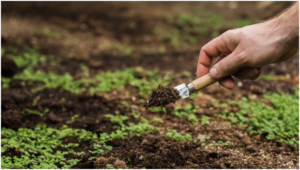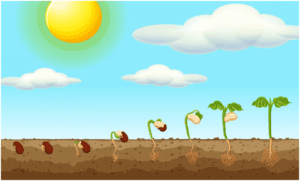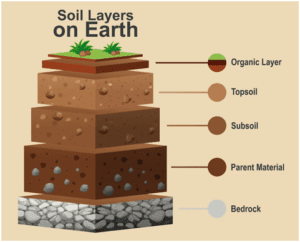Soil testing is the proper method to analyze the health and fertility of the soil. Therefore, these soil tests for agriculture help maintain a healthy composition of the soil layer for growing and harvesting. Soil health is ‘the potential of soil to function’ and is strongly linked to soil life. Soil scientists stress that the earth has to be alive to be healthy. It’s the foundation of any farm. It produces our food and performs essential ecosystem services, the state.
In its natural state, the soil layer has all the nutrients that a maturing plant needs, but owing to many external factors, the intrinsic composition of the soil is compromised. And to make up for the deficiencies in the soil, a farmer adds substitute nutrients and fertilizers into the soil. But to accurately identify these deficiencies, it is essential to conduct a soil test.

Source: Freepik
Soil Pollution:
Soil pollution or soil contamination is defined as the presence of the materials in the soil layer which are harmful to living beings when they cross their threshold concentration levels. It is caused by Industrial activity, Agricultural Chemicals, Fertilizers (Excess use) or improper waste disposal.
A soil sample can be taken from a farm and analyzed in a laboratory for its composition, nutrient levels, minerals, and physical and chemical characteristics. Regular soil testing can help us to determine its current fertility levels in case of any nutrient deficiencies, toxicity and harmful-useful minerals. It can also allow us to give early warnings of land degradation. Soil analysis helps us identify types of fertilizers and develop nutrient management plans required to improve the yield.
What are the Effects of Soil Pollution?
Soil pollution can cause a decrease in soil fertility, and therefore decrease in the soil yield. How can one expect contaminated soil to produce healthy crops? Loss of soil and its natural nutrients present in it. Plants also would not thrive in such soil, resulting in soil erosion. Foul smell due to industrial chemicals and gases might result in headaches, fatigue, nausea, etc., in many people. The creation of toxic dust is another potential effect of soil pollution.
Improving soil health:
It needs to be understood how to manage underground colonies of fungi and bacteria to our advantage. For farmers wishing to improve soil health, measurements have to be taken. Visual tests are helpful, but soil scientists recommend a combination of laboratory tests and analysis with observational data to build a knowledge base. It’s good to get into a spade routine, get familiar with the soil profile, and do visual assessments. According to soil scientists, this is accomplished with simple in-field tests and laboratory analysis, with the whole process repeated, preferably over a small area, to monitor changes. No-till is often advocated to improve soil health, and good evidence supports that, but it will only suit some, according to soil scientists.

Source: Freepik
Testing soil health in the field :
All of the methods listed in this section are low-cost and easy to implement, but each will give you slightly different insights about the health of your soil.
Earthworm counts
Earthworms are a good indicator of soil structure, health, life, and activity.
Worm numbers are best assessed in spring or autumn, advises soil scientist Dr. Jackie Stroud, founder of wormscience.org, who says it takes just 60 minutes to complete the procedure.
A spade, pot, bottle of water, mat and record sheet are required so ten 20x20x20cm soil pits can be dug per field in a standard ‘W’-shape pattern.
Soil is sorted on the mat, and earthworms are placed in the pot for counting and recording. These are separated into adults and juveniles to count and record the number of each adult earthworm type.
“There are three main types of earthworm: The epigeic or litter-dwelling earthworms, endogenic or topsoil earthworms, and anecic or deep-burrowing earthworms.”
Each group has a unique and essential function. All of them indicate the potential for specific benefits, such as carbon cycling, nutrient mobilization and water infiltration.
Each type’s target is more than one surface earthworm (epigeic) per soil pit, more than 14 for the topsoil earthworms and more than one for the deep-burrowing worms.
Lab Analysis
These soil tests for agriculture can give you results for the pH level, N-P-K, and micronutrients in your soil, along with many others. Those listed here are the ones you may be most familiar with. You take soil samples and send them to a lab, often through the Extension Service. They use a chemical extraction method to determine the nutrient content of the soil. They send you back recommendations.
Those recommendations will not include any fertilizer adjustments or lime applications. This test is better than no test but doesn’t measure the organic content or microorganisms crucial for plant resiliency.
Infiltration test
The infiltration rate is the speed water enters the soil. Measuring it helps understand how soil works with water, indicating soil structure and highlighting any compaction.
The simple in-field test requires 150x150mm metal or plastic tubing (marked at 85mm depth), water, a marked water bottle for accurate measurement and a stopwatch.
The testing area should not be saturated, so wait after a heavy downpour. Two tests per field are recommended, choosing the best and worst sites. Repeat the test at the same time each year to monitor improvements.
Insert the tube into the ground to a depth of 85mm, using a mallet if necessary, then measure out 450ml of water. Pour water steadily into the cylinder and start timing, stopping when the water has disappeared. This should then be repeated.
Introductory infiltration rates, based on FAO data, are shown below. Faster speeds can suggest good crumb structure and aggregation, such as healthy soil with high organic matter. Slower rates indicate the presence of compaction, reduced porosity (high traffic by machinery and livestock) and lower organic matter.
Soil type Infiltration rate (mm/hour)
- Sand >30
- Sandy loam 20-30
- Loam 10-20
- Clay loam 5-10
- Clay 1-5
Slake test
The slake test is a simple way of assessing soil structure. It measures the stability of soil aggregates and shows how well it can withstand external factors, so maintaining its structure to provide air and water for plants and soil biology.
Collect a handful-size chunk of topsoil from two areas; one which has not been cultivated and one which has.
Take two glass jars and some wire mesh. Mould the mesh so it can hook over the top of each jar and is large enough to hold the chunk of soil. Insert this into each jar and fill them with water, submerging the ground.
Watch to see if the soil holds together or falls apart. Soil that disintegrates has a poorer structure and lower organic matter content than one which remains intact.

Source: Freepik
Teabag index
Two popular farmer-led methods of investigating soil life involve burying either cotton underwear or teabags for a defined period to assess soil life and the decay rate of plant material.
Developed in America and the Netherlands, both systems have been easily adapted to UK soils. Burying underwear is used to demonstrate the presence (or lack) of soil biology, with a two-month burial period being enough to show whether the soil is sterile (intact underpants) or is teeming with life (only the elastic waistband left).
The tea bag index indicates the decay rate of plant material by analysing the weight loss incurred by teabags buried for three months. It helps show the relationship between soil organic matter and composting rate, with higher organic matter content soils showing faster decomposition.
Visual evaluation of soil structure (VESS)
The VESS test is another straightforward, quick procedure for assessing topsoil by its look and feel. Each of the three stages should take at most 20 minutes.
The steps are soil removal, assessment and scoring. Samples should be taken when soil is moist, from an area considered to have good soil structure and another from an area expected to have poor structure.
Step 1: Dig out a spadeful of soil to 25-30cm depth and lay it on a plastic sheet or tray.
Step 2: Open up the soil block with your hands and break it up. Look for ease of break-up and any distinct layers of differing structure.
Step 3: Break it up into distinct aggregates and give it a score, matching what you see to descriptions and photos on the SRUC chart.
The SRUC website also includes videos to help explain the VESS test, says SRUC soil scientist Dr Joanna Cloy. “It allows a quality score to be given to the soil, which indicates if soil structure needs improving.”
Drop shatter test
This is another simple test that anyone can do in 20 minutes using a spade. It is a visual method of evaluating soil, presenting the results with an overall scorecard mark. Dig a 20x20cm block of soil at field capacity – either in spring or autumn – and drop it onto a hard surface three times from a height of 1m.
This ‘drop shatter test’ lets you examine, sort and record the soil’s aggregate size and other physical factors such as porosity, colour and mottling. Using an AHDB scorecard, soils can be ranked as good (>25), moderate (10-25) or poor (<10).
Haney Test
This test estimates the quantity of nutrients available to soil microbes. This test also measures the N-P-K and pH, but the emphasis is on soil biology. It’s a soil health scorecard for a given moment in time.
Soil is a dynamic system, continually changing. A Haney Test is good to give you a baseline and then test every year and look for trends, not absolute numbers. The goal is to improve soil health yearly with natural soil amendments, cover crops, and crop rotations.
PLFA Soil Test
This tests the “phospholipid fatty acids” in your soil. The analysis of those acids indicates the soil microbial biomass. The phospholipids, mainly, are measured because they represent the currently active microbial life.
This test is often done in addition to a conventional soil test. It’s essential to remember that synthetic fertilizers have a detrimental effect on soil biology. So, if you’re using traditional practices such as tilling and using fungicides and herbicides, your PLFA tests won’t indicate your soil health in the future.
When to take soil tests?
The best time to test your soil is in the fall. You can determine what to do for the next growing season. Know that it makes a difference in what you intend on planting next year and your growing practices. Some farmers soil test in the spring, and this all depends on your region, crops grown, and historical practices.
It’s best to take soil tests every year at the same time. Keep track of crop rotations and soil test results to spot trends. If the soil’s biological content is going down, it may be time to reexamine your farming and ranching practices.
Biological soil amendments, such as rabbit fertilizer, feed the soil biology instead of only providing the plants. Over time rabbit natural fertilizers will result in better fungal/bacterial ratios in your soil and less space for pathogenic microbes.
Learn more about the soil testing process under the experts from SoilOptix®. Get in touch today!
